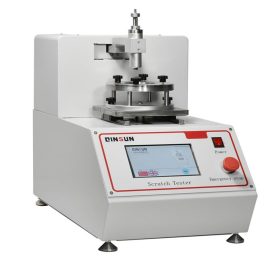
Cross reticle instrument
The electric cross scratch tester is a universal instrument used for conducting various scratch and scratch resistance tests on paint and plastic surfaces. For test pieces of different thicknesses, single or multiple row knives can be used for parallel and cross engraving (rotate the sample 90 °).
Purpose and Application
The electric scratch tester is a universal instrument used to perform various scratch and scratch resistance tests on paint and plastic surfaces. For test pieces of different thicknesses, single or multiple row knives can be used for parallel and cross engraving (rotate the sample 90 °).
Conduct adhesion tests according to the cross marking method specifically for all user standards, and conduct scratch resistance tests according to GME 60 280. The wide range of experimental parameters and multiple selection of experimental tools make these experiments easy to conduct.
The experimental results have good reproducibility and are accurate and reliable.
Design and Function
The cross cutting tester is a desktop instrument with a sturdy structure, which can also make the cutting tool stable and reliable under harsh conditions. The experimental process is controlled by PLC, and all parameters (engraving speed, engraving length, cross engraving mode) can be set with buttons. Each motion program (test piece transfer, engraving position, and required pressure adjustment) is driven by an independent stepper motor.
During the experiment, the sample moves in a straight line at a constant speed. Press the cutting edge onto the sample according to the required pressure (up to 50 N). The transmission guide ensures that the test tool tip is pressed onto the test disc according to the specified requirements. The supply scope includes two control boards for different cross engraving modes, which are easily interchangeable.
There are two types of electric grid testers, manual or motor-driven pressure regulation. The manual test pressure adjustment is simple and accurate. The motor driven pressure regulating instrument can also be tested by gradually increasing the pressure. The pressure required to achieve complete engraving can be determined during the trial engraving.
A set of 5 weights is used as a selection accessory for testing in a low-pressure range, with a test pressure ranging from 1 to 10 N in increments of 1N.
Test standards:
1. VDA 621-411 Paint adhesion
2. EN ISO 2409 Coatings - Grid cutting test for coatings
3. ASTM/D 3359 Standard Test Criteria for Coating Adhesion Testing by Tape Method
4. ISO 2409
5. JIS K 5400
6. JIS K 6894
7. SNV 3711
8. pv3974
9.pv3952
10. GMW14688
Technical data:
Dimensions (width x height x depth): 330 x 460 x 750 mm
Net weight: approximately 40 kg
Power supply: 115/230 VAC, 50/60Hz (please specify voltage when ordering)
Power: 400 W
Test piece size (* * * small): 80 x 50 mm
Test piece specification (): 105 mm wide, any length
Sample thickness: 0.5~20 mm
Standard load range: 2~50 N (2N carry)
Special load range: 1~10 N (rounded to 1 N) (must be matched with optional accessories)
Scribed path: 25 or 45 mm
Scratching speed: 1 m/min or 40 mm/s
Special performance:
Two engraving speeds and two engraving lengths can be combined according to requirements.
9 predetermined cross strokes that meet most commonly used standards.
One free program controls the cross engraving mode to meet special needs.
Set the engraving distance with a stepper motor.
When engraving through the insulation layer to the metal substrate, there will be a display.
Quick clamping device with a wide clamping range.
Cross scratch test
It can be tested according to general standards (as summarized in the table) without additional procedures. You can choose the following cross cutting method (number of cutting tools x cutting distance mm). 2x5, 6x1, 6x2, 6x3, 8x1, 8x2, 11x1, 11x2.
Continuous automatic cross cutting with a hard metal blade at a speed of 40 mm/s. Rotate the test piece 90 ° and repeat the engraving to complete the cross engraving. The load requirements for scratching the coating onto the substrate can be identified during the trial run. In the 430P-II machine (motor driven pressure regulation), this requirement is easily achieved from an automatic trial run.
When analyzing some standards, adhesive tape should be used for peeling. Adhesive tape will also be supplied to customers as accessories to meet the requirements of EN ISO 2409 (tape width 25 mm, adhesive force 10 ± 1N). The scope of supply includes a 2.5x magnifying glass for evaluating scratches. In most standards, the appearance quality can be visually compared using standard scales (scratch gauges).
Although the adhesion test using the scratch method can be compared with each other, it is not suitable to compare the results with other test methods (such as the vertical detachment test EN 24 624). Because they are different processes.
Scratch resistance test
According to GME 60280 scratch resistance test, select the blade φ 1 mm, predetermined grid spacing (20 blades, 2 mm apart). Use the same 5N pressure as the grid test, with a speed of 1 meter per minute.
When analyzing the scratch resistance test, the shell degree difference △ L is compared to the undamaged plastic surface. The illumination D65 light source can meet this requirement, and the geometric angle d/8 measurement hole can be measured φ 27 mm.
Special tests
Different GME 60 208, scratch resistance tests may also be modified using other methods
-Test blade (ball tool) φ 0.5 mm φ 0.75 mm φ 3 mm supplied as an attachment)
-Test load (2~50 N, 2N progressive or supplied with a weight kit, 1~10 N, 1N progressive as an accessory)
For the scratch test and scratch resistance test, the program setting mode can be used for any test setting, with a large side length of 40 mm. The distance between the knives can be set to a multiple of 0.5 mm. To minimize the testing time, small length cutting tools and corresponding connecting accessories are often used.